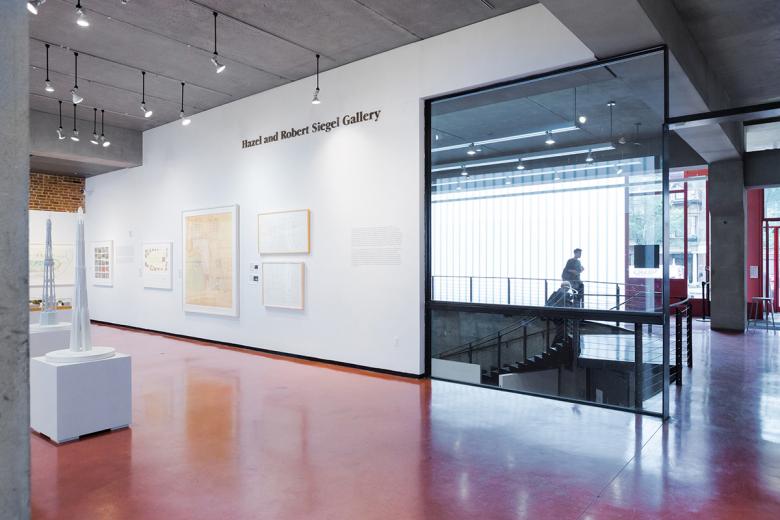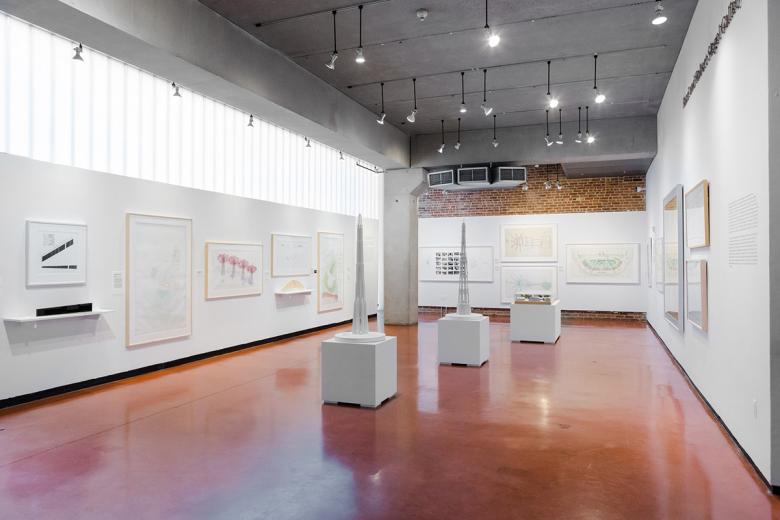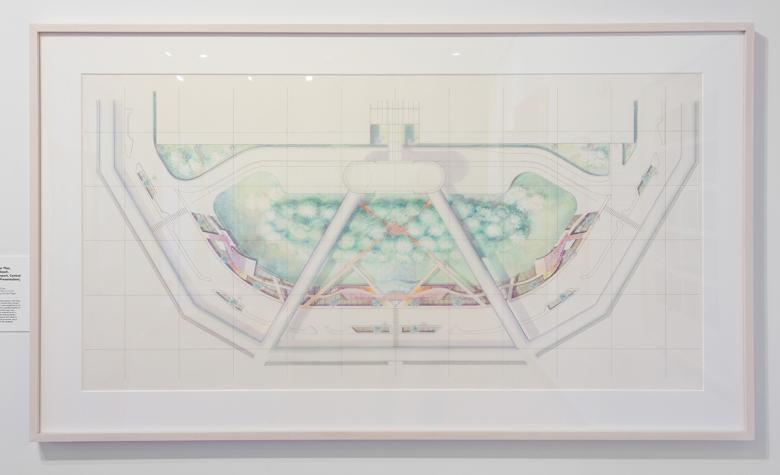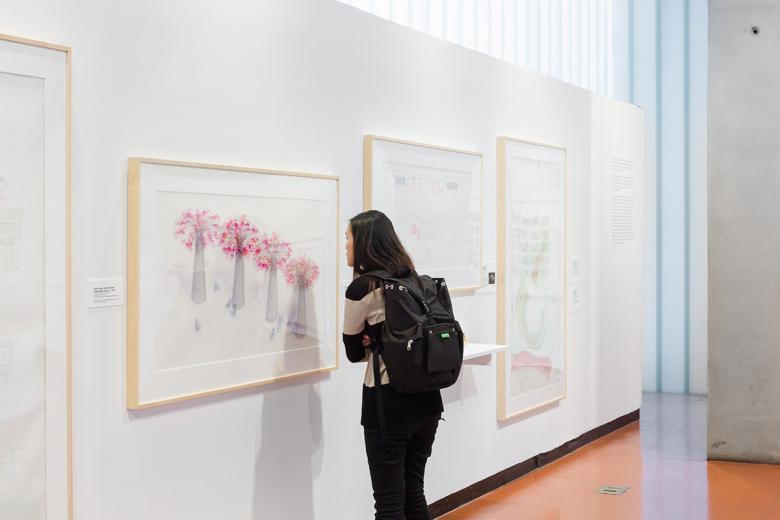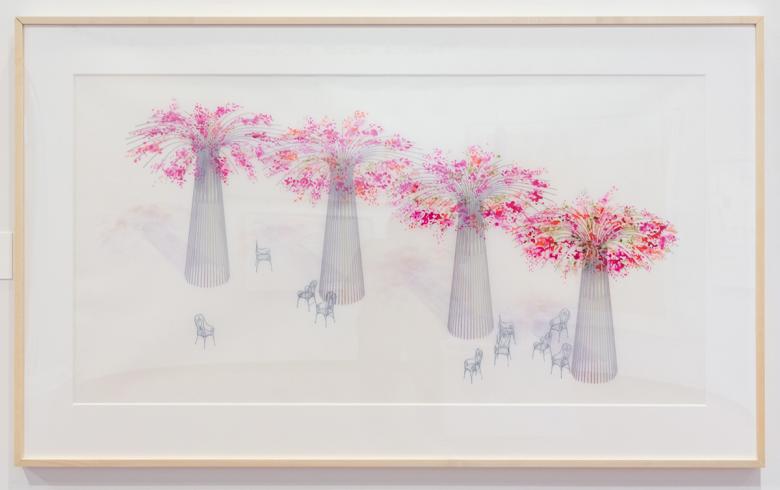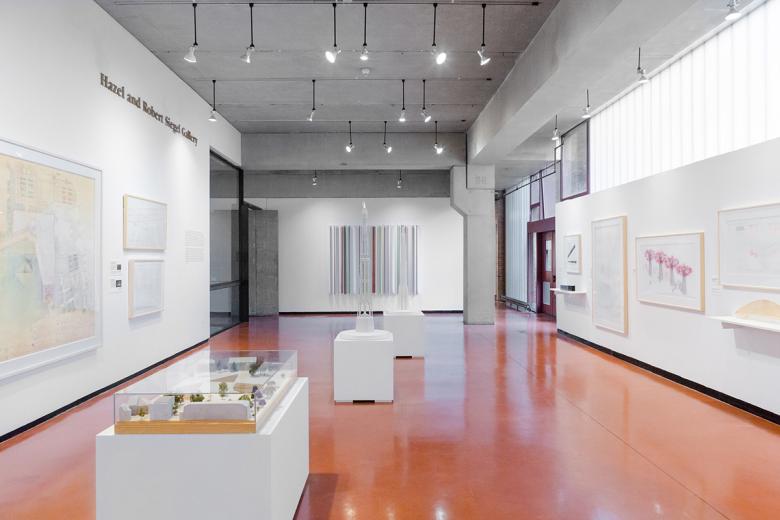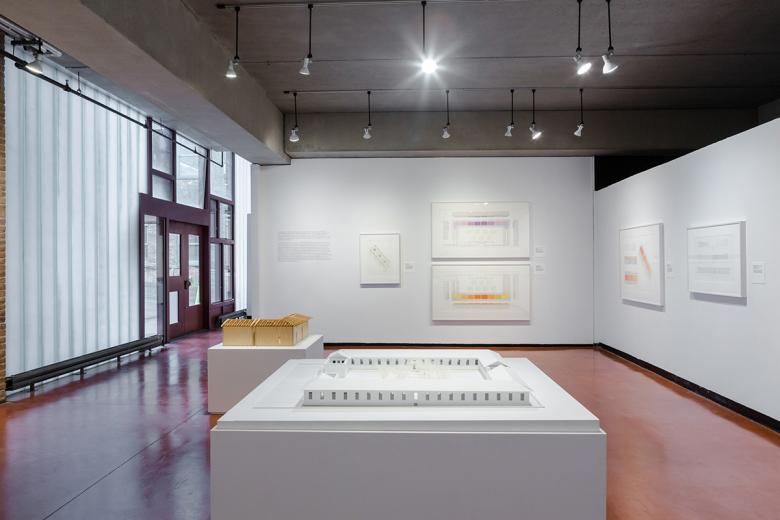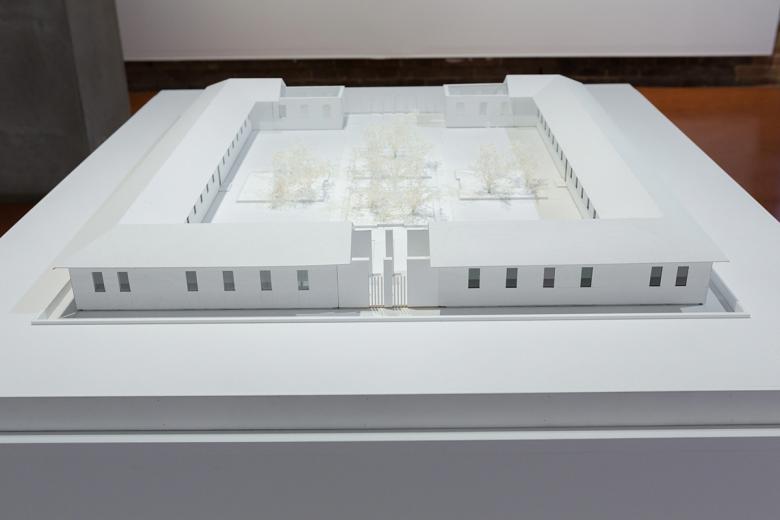Perceiving Robert Irwin
Artist Robert Irwin turned 90 on September 12th, a week after Robert Irwin: Site Determined opened at the Pratt Institute School of Architecture in Brooklyn. World-Architects editor John Hill walked through the exhibition with curator Matthew Simms to learn more about Irwin and four decades of his art.
Robert Irwin: Site Determined occupies the small two-room Hazel and Robert Siegel Gallery inside the Pratt Institute School of Architecture's Higgins Hall, whose central wing was designed by Steven Holl Architects. Completed in 2005, the Higgins Hall Insertion, as it's known, is defined by the architect's familiar translucent cast-glass facades facing north and south. These surfaces give the architecture studios upstairs and the gallery on the first floor an even light that nevertheless changes over the course of the day. This gently changing light means the appearance of the newest piece in the exhibition, Belmont Shore, varies subtly depending on the time of day and day of the year. Made of fluorescent fixtures that are never turned on but are covered in theatrical gels of various colors, the "drawing," as Irwin calls it, is an example of his site-determined art, but one whose meaning remains elusive until having absorbed the whole of the exhibition.
The exhibition, organized by the University Art Museum, California State University, Long Beach (CSULB) and curated by Simms, presents close to ten projects by Irwin spanning 40 years, from 1976 to 2016. The first date coincides with Irwin's move from galleries to outdoor environments. Initially an abstract expressionist painter, in the 1960s Irwin realized gallery installations that explored people's sensations of light and dark, most often articulated through pieces of scrim that would define volumes of light and shadow. As site-specific as could be in white-cube galleries, Irwin's art was clearly moving away from art as object to art as environment. Window Wall, his contribution to CSULB's A View Through exhibition in 1975-76, simply framed an existing path through a drywall aperture mounted in a covered portico on campus. Although temporary, it fueled the artist's appetite for permanent, outdoor commissions.
The eight projects in the first of the gallery's two rooms are anchored by two sizable landscapes, one built one unbuilt. The latter is Irwin's Arts Enrichment Master Plan proposed for Miami International Airport in 1986. Planned as a carefully controlled sequence of landscapes and art environments (many of them by artists other than himself) that reached from the highway interchange all the way to the gate, the project was endorsed by an advisory committee but faltered due to a political skirmish later that decade. Although unrealized, Irwin learned a lot about the process of large-scale projects, about how to navigate the various stakeholders involved, and about the importance of involving artists early in an architectural project. In turn, his ambitious outdoor projects were determined as much by the people and organizations involved as they were by the physical characteristics of a site.
Although site-determined may sound synonymous with site-specific, the phrase exhibit's Irwin's particular stance toward his outdoor artworks: he would let the site determine the art to such a degree that the environments he created would hardly exhibit his signature. A case in point is the other, built landscape in the first room: the Getty Center Central Garden. Easily Irwin's most famous project, the colorful, maze-like garden sits next to and just down the hill from Richard Meier's grand Getty Center. Perhaps most famous for the antagonistic relationship between Irwin and Meier (the latter had his own plans for the garden), the Central Garden is often seen as a violent contrast with the buildings' palette of aluminum and travertine. But Irwin was inspired by Meier's geometries, not just the natural features of the hilltop site, meaning both "determined" the garden's design. What comes across 21 years after the garden's completion is how much Irwin embraced plants and other natural features as elements of art; he was not afraid of using landscapes to create artistic environments, just as he was not afraid to exploit how the sun and outdoors impact the perception of his art.
The second room at Pratt is devoted to just one project: Untitled (Dawn to Dusk), completed two years ago at the Chinati Foundation in Marfa, Texas. Created by Donald Judd in the 1970s on the grounds and in the buildings of Fort D.A. Russell, Chinati is a pilgrimage site for lovers of modern art. Irwin's contribution occupies the footprint of the Fort's former hospital, a building that was donated to Chinati but would take 17 years to realize. In that time, Irwin explored various ways of occupying the C-shaped hospital, which was missing its roofs and floors. He drew plans with colored glass on new hip roofs and elevations with cuts in the walls for light to enter through the sides. In the end, with the walls unable to support a new roof, the building came down and a near-replica rose in its place to house Untitled (Dawn to Dusk), which is made up of three corridors defined by walls of scrim: a dark corridor, a light corridor, and a corridor that transitions between the two. Light is brought into these spaces through small windows that are elevated to frame views of the sky, the "element" that first pushed Irwin toward colored glass roofs.
To say that Irwin's artwork occupies the building, though, is a disservice to the artist and what he's created, what might be rightly considered his magnum opus. In reality, he has created a piece of art-architecture: a building that serves as a piece of art. Even before he was faced with tearing down the old hospital, he treated the building as a large, three-dimensional canvas to be cut up and reconfigured in various ways toward the heightened awareness of the place. As built, Untitled (Dawn to Dusk) is, in the words of Sarah Urist Green of PBS Digital Studios, "Incredible. This experience far exceeds 99% of art encounters I've had." (Click the link to watch her walkthrough of the artwork.) Combined with the landscaped courtyard the building embraces, the installation in Marfa must be Irwin's ideal: a creation that blurs the long-held distinctions between art and architecture, and which elevates each in the process.
Returning to Belmont Shore — named for a neighborhood in Long Beach, California, the town where Irwin was born — it's clear that Irwin's art is about perception. But perception is not just looking; it is bodily perception, experiencing environments, places through his artworks. Given that Robert Irwin: Site Determined is limited to his (very architectural) drawings and models, it's impossible to fully grasp the perceptual qualities of the Getty Center Garden, for instance, or his artwork in Marfa. So Belmont Shore acts as a stand-in, a surrogate "drawing" that invites visitors to ponder their perception of the piece. In turn, visitors can grasp how Irwin modifies our perception through subtle yet myriad interactions of form, color and light.
Robert Irwin: Site Determined was organized by the University Art Museum, California State University, Long Beach (CSULB) and curated by Matthew Simms. First exhibited at CSULB (28 January 2018 – 15 April 2018), it is on display at Pratt Institute School of Architecture in Brooklyn, New York, until 30 November 2018.

